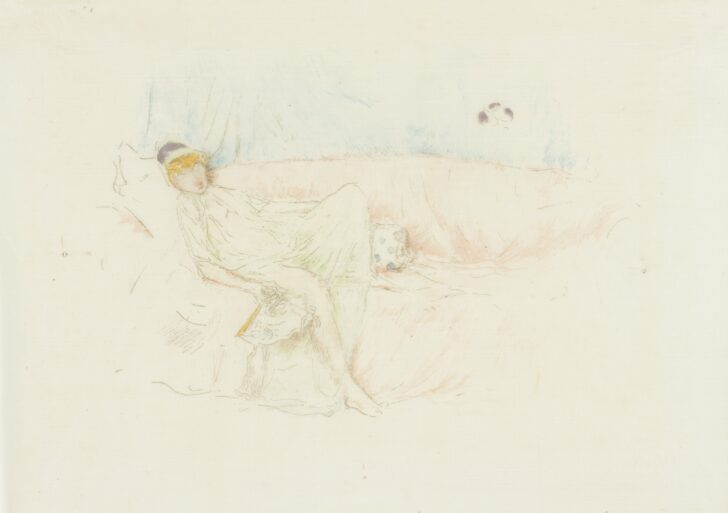Draped Figure Reclining
James Abbott McNeill Whistler

Description
Draped Figure, Reclining
1893–94
Transfer lithograph, printed in six colors, on laid Japan tissue
Second state of two (Way 156; Chicago 56)
Bequest of Margaret Watson Parker, 1954/1.468
This delicate lithograph shows how expertly Whistler combined the elements of his work to create the richest resonance among color, image, and medium. Working with the master printer Henri Belfond in Paris, he oversaw the color mixing and printing of this image himself, adjusting the color of each impression to harmonize with that of the paper being used—warmer hues on cream paper, cooler colors on white or ivory papers. This impression is particularly light and luminous; Whistler’s ability to convey the diaphanous quality of the drapery is superbly matched to the translucent and gossamer quality of the paper.
---
March 28, 2009
Whistler’s taste for understatement and suggestion reaches its apogee in a work such as the Draped Reclining Figure—one of his exceedingly rare color lithographs. During the mid-1890s, Whistler made a number of works in paint, pastel, and lithography depicting female figures in diaphanous drapery. The elements of the work are minimal: a female figure recumbent on a couch, holding a fan. That so much can be conveyed through so little is a testament to Whistler’s delicate handling of the medium.
In this period technical improvements had made lithography a satisfying medium for further exploration. The most critical change was the introduction of transfer paper as the support, rather than a stone. This allowed Whistler to carry a folio of transfer paper sheets, making lithographs nearly identical in process to drawings. The printing of the drawing (which is transferred from the transfer paper to a stone and then printed as a standard lithograph) is treated differently in each of the handful of impressions of this image—the coloration, for example, varies slightly. Whistler’s sensitivity to the medium extends to his choice of paper, here a translucent Japan tissue that reiterates the gauzy diaphanous quality of the drapery.
Subject Matter:
The female figure, both draped and nude, was a subject matter that occupied Whistler beginning the 1860s. This was drawn in his studio in Paris and was printed (as with Yellow House, Lannion) by Henri Belfond. This rare and exquisite print shows how skillfully Whistler matched his image to the paper employed: the diaphanous drapery of the reclining figure is superbly evoked through the translucent quality of the Japan tissue.
Physical Description:
A female figure, dressed in diaphanous green drapery with a purple and green cap over her curly blond hair, holds a fan as she reclines on a cloth-covered couch. Her left leg is up on the couch while her right leg and arm drape over the front of the couch; a patterned pillow seen near her left leg mirrors the colors on the fan. The wall behind them also appears to be draped with fabric. On the wall to the right is a flower-like symbol that is the artist's "butterfly" signature
Usage Rights:
If you are interested in using an image for a publication, please visit https://umma.umich.edu/request-image/ for more information and to fill out the online Image Rights and Reproductions Request Form.